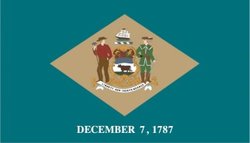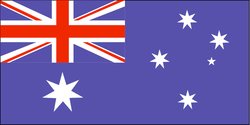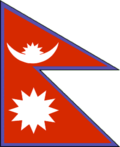Flag
|
|
A flag is a piece of cloth flown from a pole or mast, usually intended for signaling or identification. Flags were initially created for signalling (as in semaphore), and for the identification of those who displayed them, and are still used for that purpose today. Flags are also used in messaging or advertising, or for decorative purposes, though at this less formal end the distinction between a flag and a simple cloth banner is blurred. Generally, a piece of cloth is a flag if it is flown like a flag, with one side attached, though many flags are recognisable if displayed in other forms.
The study of flags is known as vexillology, from the Latin vexillum meaning flag or banner.
| Contents |
History
Although flag-like symbols have been used by ancient cultures for thousands of years, the origin of flags in the modern sense is a matter of dispute. Some believe flags originated in China, others held that the Roman Empire's vexillum was the first true flag.
During the Middle Ages, flags were used mainly during battles to identify individual leaders: in Europe they were the knights, in Japan they were the samurai, and in China they were the generals under the imperial army.
From the time of Christopher Columbus onwards, it has been customary (and later a legal requirement) for ships to carry flags designating their nationalities; these flags eventually evolved into the national flags and maritime flags of today. Flags also became the preferred means of communications at sea, resulting in various systems of flag signals (see International maritime signal flags).
Beginning at the 17th Century, European knights were replaced by centralized armies, and flags became the means to identify not just nationalities but also individual military units. Flags became much more elaborate, and were seen as objects to be captured or defended. Eventually these flags posed too much danger to those carrying them, and by World War I these were withdrawn from the battlefields, and have been used only at ceremonial occasions ever since.
National flags
Main article: National flag
One of the most popular uses of a flag is to symbolize a nation or country. Some national flags have been particularly inspirational to other nations, countries, or subnational entities in the design of their own flags. Some prominent examples include:
- The flag of Denmark. This flag, called the Dannebrog, inspired the cross design of other Nordic countries. Examples: the Faroe Islands, Finland, Iceland, Norway, Sweden, Ŭand.
- The flag of Switzerland, with its colours reversed, gave rise to the emblem of the International Red Cross, which is a safe conduct in war zones under international law.
- The Union Flag of the United Kingdom, more commonly (and correctly, when used by warships at sea) called the "Union Jack". British colonies typically fly a flag based on one of the ensigns based on this flag, and many former colonies have retained the design to acknowledge their cultural history, show gratitude to the UK, or possibly to reflect their participation in the Commonwealth. Examples: Australia, Fiji, New Zealand, Tuvalu, and curiously Hawaii.
- The national flag of France, also called the Tricolore, which inspired other nations to adopt differenced tricolours in sympathy with the revolutionary spirit with which the flag was designed in 1794. Examples among many: Ireland, Italy, Mexico.
- The flag of the United States, also nicknamed The Stars and Stripes or Old Glory. In the same way that nations looked to France for inspiration, many countries were also inspired by the American Revolution which they felt was symbolized in this flag. Examples: Cuba, Chile, Liberia, Malaysia.
- The flag of Russia, the source for the Pan-Slavic colors adopted by many Slavic states and peoples as their symbols. Examples: Slovakia, Serbia and Montenegro, Croatia, Bulgaria.
- Ethiopia was seen as a model by emerging African states of the 1950's and 1960's, as it was one of the oldest continually independent states in Africa. Accordingly, its flag became the source of the Pan-African colours. Examples: Togo, Senegal, Ghana, Mali.
- The flag of Turkey which was originally the flag of the Ottoman Empire has been an inspiration for the flag designs of many other Muslim nations. During the time of the Ottomans the crescent began to become associated with Islam and this is reflected on the flags of Algeria, Comoros, Malaysia, Mauritania, Pakistan, and Tunisia
- The Pan-Arab colors, green, white, red, and black, seen on the flags of Jordan, Kuwait, Sudan, Syria, the United Arab Emirates, Western Sahara, Yemen and on the Palestinian flag.
- The Soviet flag, with its golden symbols of the proletariat on a red field, was an inspiration to flags of other communist states, such as East Germany, People's Republic of China, Vietnam, Angola, Afghanistan and Mozambique.
- The flag of Nepal is the only non-rectangular national flag in the world.
Flags at sea
Main article: Maritime flags
Flags are particularly important at sea, where they can mean the difference between life and death, and consequently where the rules and regulations for the flying of flags are strictly enforced. A national flag flown at sea is known as an ensign. A courteous, peaceable merchant ship or yacht customarily flies its ensign (in the usual ensign position) together with the flag of whatever nation it is currently visiting at the mast (known as a courtesy flag). To fly one's ensign alone in foreign water, a foreign port or in the face of a foreign warship traditionally indicates a willingness to fight, with cannon, for the right to do so. This custom is still (2004) taken quite seriously by many naval and port authorities and is readily enforced in many parts of the world by boarding, confiscation, and other civil penalties.
In some countries yacht ensigns are different from merchant ensigns in order to signal that the yacht is not carrying cargo that requires a customs declaration. Carrying commercial cargo on a boat with a yacht ensign is smuggling in many jurisdictions.
There is a system of International maritime signal flags for each numeral and letter of the alphabet. Each flag or pennant has an additional meaning when flown individually.
Shape and Design
See also Flag terminology.
Flags are usually rectangular in shape, but may be of any shape or size that is practical for flying. Named shapes include square (e.g., the national flag of Switzerland and the state flag of the Vatican City), pennant, double pennant (e.g., the state flag of Ohio), swallowtail, triangular or swallowtail burgee, gonfanon and oriflamme. A more unusual flag shape in use includes that of the national flag of Nepal, which is vaguely in the shape of two stacked triangles.
Common designs on flags include crosses, stripes, and divisions of the surface, or field, into bands or quarters - patterns and principles mainly derived from heraldry. A heraldic coat of arms may also be flown as a banner of arms, as is done on both the state flag of Maryland and the republic flag of Kiribati. Writing is common on some flags---for example, on several flags of U.S. states, or on revolutionary flags of the former Soviet Union. This practice is generally deprecated, as such writing is usually difficult to read on the reverse of a flag, is expensive to reproduce accurately, and makes the flag too heavy to fly properly (when the lettering is sewn on both sides of a flag). Some flags have a different design on each side, as is demonstrated by the former national flag of Paraguay, the state flag of Oregon, and the now-obsolete flag of the Soviet Union.
In sports
- In American and Canadian football, referees use flags to indicate an error has been made in game play. The phrase used for such an indication is flag on the play. The flag itself is a small, weighted handkerchief, tossed on the field at the approximate point of the infraction; the intent is usually to sort out the details after the current play from scrimmage has concluded. In American football, the flag is usually yellow; in Canadian football, it is usually red.
- In auto and motorcycle racing, flags are used to communicate with drivers. Most famously, a checkered flag of black and white indicates the end of the race, and victory for the leader. A yellow flag is used to indicate caution requiring slow speed and a red flag requires racers to immediately stop. A black flag is used to indicate penalties.
- In Association football (soccer), assistant referees carry small flags along the touch lines. They use the flags to indicate to the referee potential infringements of the Laws or who is entitled to possession of the ball that has gone out of the field of play, or, most famously, raise the flag overhead to indicate an offside offence. Officials called touch judges use flags for similar purposes in both codes of rugby.
- In addition, fans of almost all sports will wave flags in the stands to indicate their support for the participants. Many sports teams have their own flags, and in individual sports, fans will indicate their support for a player by waving the flag of his or her home country.
- Capture the flag is a popular children's sport.
Railway flags
Railways use a number of coloured flags, usually with the following meanings:
- red = stop
- yellow = proceed with care
- green or white or blue = proceed.
- a flag of any colour waved violently means stop
At night, the flags are replaced with lanterns showing the same colours.
Railway signals are a development of the railway flags.
Flagpoles
A flagpole, or flagstaff, can be simple supports made of wood or metal. If it is taller than can be easily reached to raise the flag, a string is used, looping around a pulley at the top of the pole with the ends tied at the bottom. The flag is fixed to one lower end of the string, and is then raised by pulling the other end. The string is then tightened and tied to the pole at the bottom.
Very high flagpoles may require more complex support structures than a simple pole, such as guy wires, or to be built as a mast. The highest flagpole in the world, in Gijeong-dong, North Korea, is 160 metres tall, and the flag weighs about 270 kilograms when dry. But the biggest flag which hosted is the Brazilian Flag in the Three Powers Place in Brasilia, Brazil. The Flag weighs about 600 kilograms when dry and measures 70m x 100m size. This flag can be seen from all parts of Brasilia. It is the tallest structure in the city.
See also
- Gallery of flags
- List of flags
- List of Lists of Flags – sorts flags by colour and number of colours
- Flag Day
- Flag Terminology
- Vexillology = Bannistics
- Vexillological symbols
- Flag desecration
- Flag throwing
- Flagpole annexation
- Standard-bearer (also enumerates various types of standards, both flag types and immobile ensigns)
References
- William G. Crampton; The World of Flags; Rand McNally; ISBN 0-528-83720-6 (hardcover, 1994).
- Ultimate Pocket Flags of the World; Dorling Kindersley; ISBN 0-7894-2085-6; (1st American edition, hardcover, 1996).




